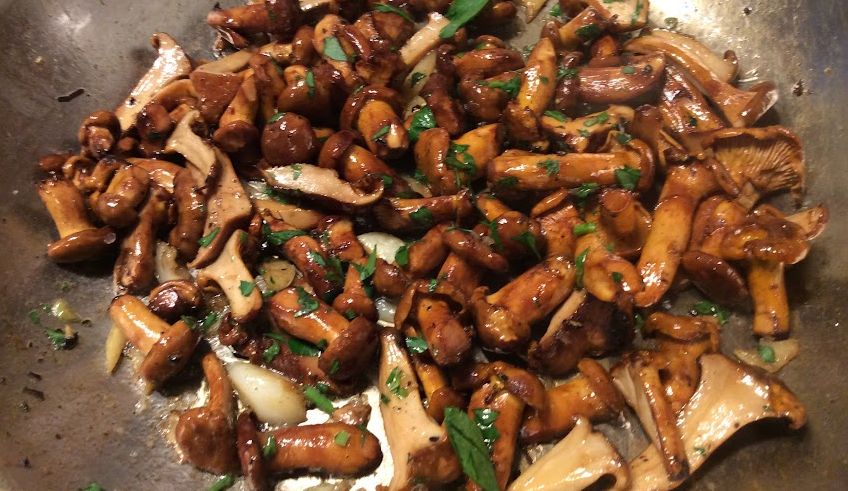
Years ago, at a Fall trade show in Frankfurt, we went to the grocery shop across from our apartment to get food supplies. It was a very good neighborhood grocery, with excellent fruits and vegetables, even in October. They had a fine selection of bottled waters, cut flowers, and cheeses. And, they sold wild mushrooms, chanterelles, called pfefferlingen in German. There was a great array of them on the table. Below the table there were three large fruit boxes, each labeled Wild Chanterelles from Washington State.
I have never seen these boxes here in Washington State. We have an odd relationship with wild mushrooms here. Perhaps it is a legacy of the hallucinogenic variety, or a flinch to the numerous quite deadly variety that also grow here.
Whatever the case, no one particularly eats wild mushrooms here, at least not many. In Germany, in Europe, every family will eat wild mushrooms during the season, and every restaurant will serve them. They are not available here easily and when they do show up in the grocery store, they typically do not appear at their best. It is odd, and a shame. We have brilliant forests for the chanterelle and the porcini, for the lobster mushroom and the matsutake. Yet, they are considerably more famous in other countries, than here at home.
Many of the farmer’s markets here in Seattle now will offer wild mushrooms. In the Pike Market, Sosio’s and Frank’s have always been the best suppliers. The price will be very high at first and then, as the season opens, they will be modest.
Best of course would be learning to forage for them yourself. There are classes and neighbors and such, and once you get the hang of it, you will never let it go. They are quite beautiful, very healthy and the best of allies to eating well. We laughed to see a sign, “organic chanterelles.” It could as easily said, “organic rain” for there is no other kind.
Use this method with any fresh wild mushroom. It is the clearest presentation of taste, and texture and distinction. It is what I do with the first chanterelles and the first porcini.
Heat a little olive oil and 1 tbsp of cold butter, on medium, in a 10″ saute pan. Add the mushrooms, no more than 1/2 lb., chopped a bit except for the smallest. Sauté to mix and coat and heat, then add 2 finely chopped cloves of garlic, a little dry white wine, salt and pepper and some chopped parsley. Stir and cover for two minutes, turning the heat down just a bit.
Uncover, and stir, they should be slightly sticking to the pan. Stir again and add a second tbsp of cold butter. Stir and add a little more chopped parsley, and 2 tbsp of cold water, stock, or a squirt of lemon. Cook for a minute or two, then take off the heat. Serve, on a warm plate, with fresh cracked pepper and a little olive oil on top. There should be the merest amount of sauce.
Have fresh toast or pita near, with olive oil and salt and pepper on it. The garlic, parsley and butter are meeting their oldest pal, the wild mushroom, who has been away, in the deepest woods.
Never wash wild mushrooms. Brush them with a pastry brush, wipe them with a clean, damp cloth. Lay them out like prizes. They are prizes of the woods.
That said, there are times, especially early in the season, when the chanterelles, in particular, are best quickly rinsed in cold water. It has not rained, the chanterelles are wonderfully small, tawny and tight and beautifully white on the interior. We always call them the Queen’s mushrooms, the perfect new ones of each season. The best of messengers.
Later the chanterelles will bloom like a daffodil, the rains will come, and there may be times you must lay the mushrooms out on a cotton towel to let some of the moisture in them release.
But for these early days, when the chanterelles are growing up through hot, dry soil, they can use the slightest moisture. Once they are cleaned, you can rinse them suddenly in cold water. Then lay them on a strainer. Start your cooking and add the mushrooms while they are still damp. It will help to get a little moisture into their tight form. Typically, I do not chop these first mushrooms, I simply open them in half – and leave whole the smallest ones.
Later in the season, you will need to work to get the moisture OUT of them instead.
Discover more from Post Alley
Subscribe to get the latest posts sent to your email.

“Later the chanterelles will bloom like a daffodil, the rains will come…” someone finally captures what it’s like to love mushrooms beyond all reason.
Peter,
For a number of years, Costco carried those boxes of Chantrelles.
Sometimes they were from Washington, sometimes from Oregon and sometimes from BC.
But, for unknown reasons, for the past several years they have not had them.
I do miss them, either prepared as you describe or in a wonderful chantrelle soup I’ve made for years.
Maybe this year at Costco? Or not, sigh!
Love chanterelles, fresh from the forest. But there are others worth harvesting: shaggy manes, boletes and matusakis (sp?) The Northwest is a ‘shroom lovers paradise.
Apologies. I slaughtered the spelling of matsutakes, pine mushrooms. They are considered by many to be the finest of our local fungi.